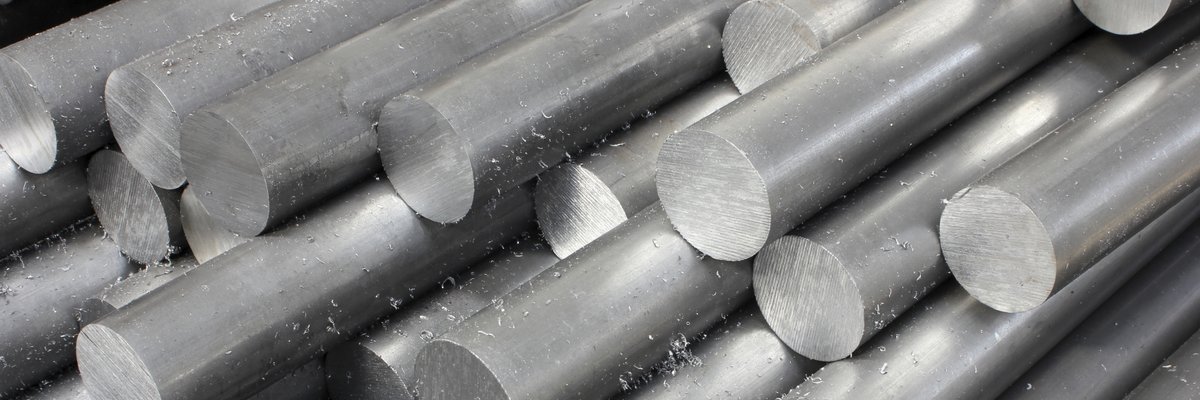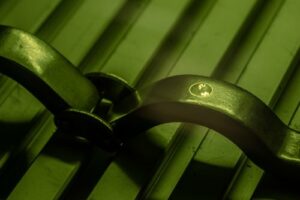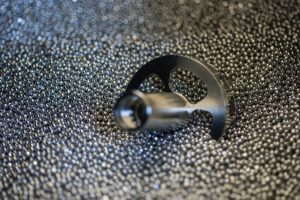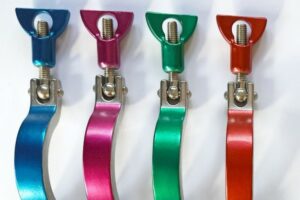The different grades of stainless steel

Stainless steel is an alloy of iron and carbon containing more than 50% iron, at least 10.5% chromium and less than 1.2% carbon. Its main characteristic is a good resistance to corrosion, thanks to the formation of a protective layer of chromium oxide on the surface (stainless steel passivation phenomenon).
The addition of other elements gives interesting properties to the stainless steel grade: nickel for mechanical properties, titanium and molybdenum for stability and corrosion resistance (especially in saline environments).
According to their composition, stainless steels are classified into 4 families: martensitic (group C), ferritic (group F), austenitic (group A), and austeno-ferritic (group AF).
Spécialisés dans l’usinage de l’inox et la fabrication de raccords et pièces de robinetterie en métal pour l’industrie, nous utilisons principalement des inox austénitiques (au moins 17% de chrome et 7% de nickel, avec addition de de molybdène, titane, niobium, cuivre…), qui sont adaptés à la plupart des utilisations. Dans cette gamme, nous privilégions l’inox 316 et l’inox 316L (bas carbone) pour une utilisation dans l’industrie chimique ou pharmaceutique.
Specialized in the machining of stainless steel and the manufacture of metal fittings and valves for industry, we mainly use austenitic stainless steel (at least 17% chromium and 7% nickel, with the addition of molybdenum, titanium, niobium, copper, etc.), which are suitable for most uses. In this range, we favour 316 stainless steel and 316L stainless steel (low carbon) for use in the chemical or pharmaceutical industry.
We are also one of the few manufacturers to machine superalloys (Inconel®, Hastelloy®, Uranus®, Duplex) to make special metal parts for industry, requiring high quality metal for high safety conditions.
European standard
The European standard EN 10088 is the standard used on general purpose stainless steel. It imposes a symbolic or numerical nomenclature for the designation of grades.
Symbolic designation: X followed by the carbon content, followed by the content of other elements, in descending order. For example: X12Cr13 (0.12% carbon, 13% chromium)
Numerical designation : 1.4 followed by 3 digits; the 3rd digit indicates the chemical composition of the grade. Example: 1.4404
1.40xx -> Ni less than 2.5%, no Mo, Nb or Ti
1.41xx -> Ni less than 2.5%, with Mo, without Nb or Ti
1.43xx -> Ni higher than 2.5%, no Mo, Nb or Ti
1.44xx -> Ni higher than 2.5%, with Mo, without Nb or Ti
American standard
The AISI (American Iron and Steel Institute) proposes a naming standard based on 3 digits and an optional suffix (L for Low Carbon).
We prefer to use 316L stainless steel (AISI) which offers the best resistance for industrial use. Indeed, stainless steel with a high carbon content creates a chromium carbide zone when subjected to high heat (especially during welding). As a result, the protective layer of chromium oxide is reduced in certain areas: low-carbon stainless steels (L) do not have this problem.
| Groupe | AISI | EN Symbolic | EN Numerical | corrosion resistance | field of use | breaking strength (Rm) in MPA |
| A1 | 303 | X8CrNiS18-9 | 1.4305 | Weak in acid and chloride media, good in nitric acid (up to 52% at all temperatures, 98% when cold), cold diluted organic acids, alkaline solutions (except chlorides, sulphites and sulphates), fresh water and natural atmospheres, foodstuffs (except mustard and white wine), lubricants, oils and greases | Transport, mechanical industry, machining | 500-750 |
| A1 | 304 | X5CrNi18-10 | 1.4301 | Good in Nitric acid (up to 52% at all temperatures, 98% when cold), cold diluted organic acids, alkaline solutions (except chlorides, sulphites and sulphates), fresh water and natural atmospheres, food products (except mustard and white wine)) | Transport, mechanical industry, machining | 500-700 |
| A2 | 304L | X2CrNi18-9 | 1.4307 1.4306 |
Acide nitrique (jusqu’à 52% à toutes températures, 98% à froid), acides organiques dilués à froid, solutions alcalines (sauf chlorures, sulfites et sulfates), eaux douces et atmosphères naturelles, produits alimentaires (sauf moutarde et vin blanc) | Forgeage, usinage de pièces mécaniques pour industrie chimique et alimentaire | 450-680 |
| A4 | 316 | X5CrNiMo17-12-2 | 1.4401 1.4436 1.4408 |
Nitric acid (up to 52% at all temperatures, 98% when cold), cold diluted organic acids, alkaline solutions (except chlorides, sulphites and sulphates), fresh water and natural atmospheres, food products (except mustard and white wine) | Nitrogen explosives industry, chemical industry, food industry | 500-700 |
| A4 | 316L | X2CrNiMo17-12-2 GX2CrNiMo19.11.2 |
1.4404 1.4409 |
Phosphoric acid (all concentrations up to 40°C), sulphuric acid (less than 10% and more than 80% at 20°C), sulphonitric mixtures (up to 70°C), sulphurous solutions and vapours, even if hot (except if sulphuric acid is formed), organic acids, even if they are boiling, saline solutions (except for chlorides), alkaline solutions (all concentrations below 100°C), fresh water and natural atmospheres (especially marine), organic products, foodstuffs | Nitrogen explosives industry, chemical industry, food industry, mechanical industry | 500-700 |
| A4 | 316L | X2CrNiMo18-14-3 | 1.4435 | Excellent resistance in natural environments (even in the presence of moderate concentrations of chlorides and acids), in food and food processing environments, and in many acidic and chloride environments. Resistance to intergranular corrosion even after welding. | Jewelry, chemical industry, petrochemical industry | 500-700 |
| A4 | 316Ti | X6CrNiMo17-12-2 | 1.4571 | Phosphoric acid (all concentrations up to 40°C), sulphuric acid (less than 10% and more than 80% at 20°C), sulphonitric mixtures (up to 70°C), sulphurous solutions and vapours, even if hot (except if sulphuric acid is formed), organic acids, even if they are boiling, saline solutions (except for chlorides), alkaline solutions (all concentrations below 100°C), fresh water and natural atmospheres (especially marine), organic products, foodstuffs | Chemical industry, food industry, mechanical industry | 500-700 |
| A4 | 321 | X6CrNiTi18-10 | 1.4541 | Excellent resistance in natural environments (in the absence of significant concentrations of chlorides or acids), in food and agri-food environments (except mustard, white wine), and in certain chemical environments (nitric acid, cold diluted organic acids) Resistance to intergranular corrosion, even after welding |
Chemical, food and agri-food industry | 530-690 |


